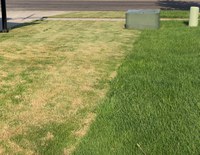Dakota Gardener: The science of mowing your lawn
(Click an image below to view a high-resolution image that can be downloaded)
By Esther E. McGinnis, Horticulturist
NDSU Extension
My husband and I were invited to a housewarming party. The young couple had purchased their first home. As a horticulturist, I immediately noticed their unhealthy-looking lawn as we pulled up to their house. They were cutting their lawn too short and it was turning brown.
As a trained professional, I wanted to give them simple advice to improve their lawn’s health. Fortunately, my husband cautioned me about giving unsolicited advice and potentially ruining our friendship. Instead, I am providing this advice to our Dakota Gardener readers.
Don’t mow your lawn too short! A direct correlation exists between the length of the turfgrass blade and the length of the root system. If you want to have a deep root system that can tolerate drought, mow on the higher side. Conversely, mowing short results in a shallow root system that requires more irrigation.
The optimum length for Kentucky bluegrass and fine fescue lawns is 3 to 3.5 inches. For a lot of lawn mowers, this is the highest setting. You can check this by measuring from the ground to your mower blade using a ruler.
A second rule of thumb is to mow frequently enough to avoid cutting off more than one-third of the turf blade. Turfgrass is composed of thousands and thousands of individual plants that need to photosynthesize to produce carbohydrates that fuel plant growth and development. If you remove too much green tissue, the plant is less able to produce its own food and will experience stress.
Did you know that you can go longer in between mowings if you follow the above two rules? It is a simple matter of math. If you are maintaining a 3-inch tall lawn and not removing more than one-third of the turfgrass blade, you would mow when the lawn reaches 4.5 inches and cut off 1.5 inches. In contrast, if you are maintaining a 2-inch lawn, you would mow at a 3-inch height and remove 1 inch. In the above example, the homeowner maintaining a 3-inch tall lawn would be able to let the grass grow an extra ½ inch before mowing.
When you mow, don’t collect and remove your lawn clippings. Instead, allow the clippings to fall back to the ground. Many people mistakenly assume that they will cause a thatch problem. This is a myth. Lawn clippings are primarily water and will decompose quite readily. Furthermore, they contain nitrogen. If you collect your clippings, you are removing nitrogen from the lawn and will need to do an extra fertilizer application to make up for it.
To prevent ruts in your lawn, don’t take the same path across the lawn every time. Next time, consider mowing in a perpendicular direction.
The final mowing tip is to keep your lawn mower blade sharp. A dull mower blade tears the grass blade and results in a jagged edge on the turf blade. This jagged edge is more likely to cause water loss.
NDSU Agriculture Communication – June 20, 2023
Source: Esther McGinnis, 701-231-7406, esther.mcginnis@ndsu.edu
Editor: Kelli Anderson, 701-231-7881, kelli.c.anderson@ndsu.edu




